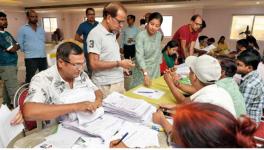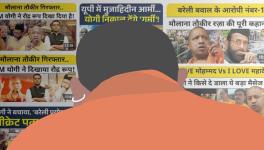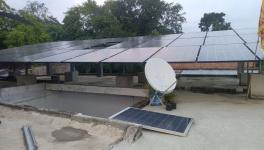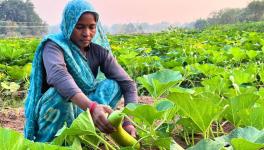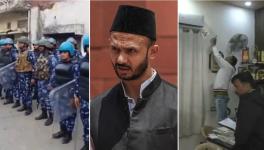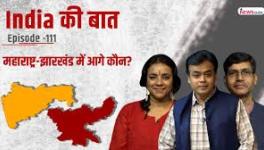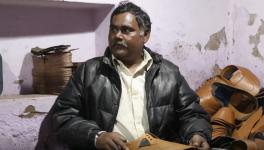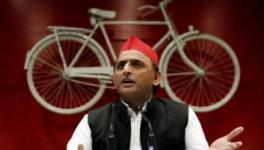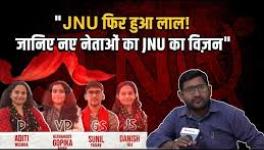Lives of Peasants in India #12
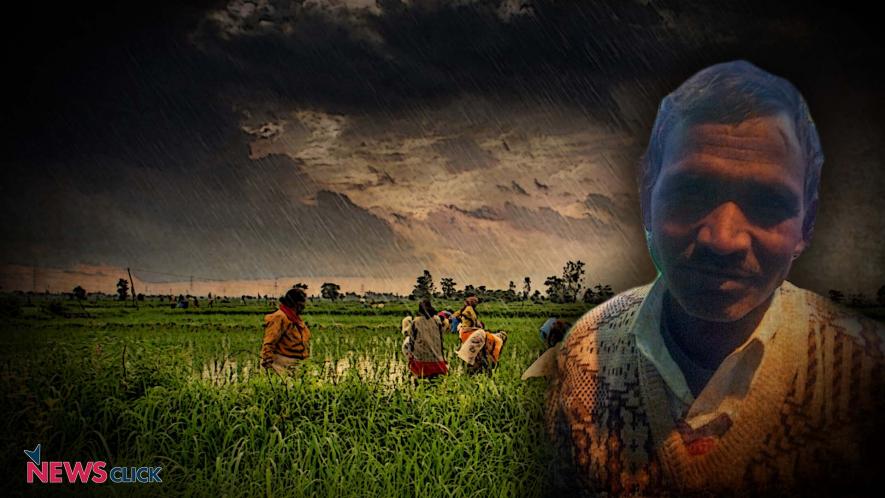
Newsclick Image by Sumit
The year 2017 saw an outpouring of farmers’ protests sweeping the country. To understand why they happened, NewsClick presents a series of profiles of farmers from different parts of India, based on interviews done by students from Delhi, guided by the Society for Social & Economic Research (SSER). See Introduction to series.
Keshav Lal came to the Kisan Sansad from Chak Ahamadipur, a village in Manjhanpur tehsil of Kaushambi district, Uttar Pradesh. He is 55 years old. Although he never got a chance to go to school, he has educated himself through an adult literacy program. Keshav Lal’s household has 0.15 acres of tubewell-irrigated land. Besides cultivating the land, Keshav also works as a construction worker. His wife, aged 48 years, works as a daily wage labourer, doing agricultural or non-agricultural work, whatever is available.
Keshav has two sons and one daughter. The eldest son, aged 22 years and educated up to class 9, is also a daily wage labourer. His wife, who is 20 years old, continues to study in college. The other son is 18 years old and has studied up to class 8. He has gone to Mumbai and works as a tailor there. Keshav’s daughter is 17 years old and is also studying in college.
Last agricultural year (2016-17), Keshav's household grew paddy in the kharif season, and got 3.5 quintals of it from their 0.15 acres of land. After that, in the rabi season, they grew wheat on 0.1 acres and potato on 0.05 acres of land.
Keshav had spent about Rs. 3000 on seeds, fertilisers and other inputs for the potato crop. The household had to labour very hard on the crop. The land had to be ploughed several times to loosen it enough for the potatoes to grow. Keshav’s wife prepared the seed material which they both planted in the field. Before they planted pieces of seed potatoes, furrows had to be prepared in the field so that, once the seed potato is planted, water would flow properly to wet all the land equally. A crop like potato, Keshav Lal said, needs to be irrigated carefully as stagnant water on any part of the land can destroy the potatoes. Until the potatoes grew, the land had to be irrigated and weeded periodically. In February 2017, when the potatoes were almost ready to be dug out, the prices of potato in Kaushambi crashed to such a low level that Keshav realised he would be making losses in the crop. In fact, the prices were so low that he would not have recovered even the cost of harvesting and transport to Manjhanpur from Chak Ahamadipur. So, they harvested 7 quintals of potato for their own requirement and gave away some to friends and relatives. Rest of the crop was abandoned in the field itself.
Keshav Lal chose to quickly abandon the crop and sow wheat on this land. He paid for the tractor, so that the land could be ploughed quickly. Since a lot of fertiliser had been applied for the potato crop, they did not have to add any more fertiliser for the wheat crop. The family worked on this plot of land again for the next three months and harvested 75 kilograms of wheat.
Keshav and his family do all the labour on the land themselves. However, with the extra work for sowing the late crop of wheat, Keshav had to hire a worker to help with harvesting the early wheat they had sown on 0.1 acres of land. In the end, with this additional expense factored in, they incurred a loss of Rs. 950 over paid out expenses on the 0.1 acre of early wheat. In the second crop of wheat, sown after potato, they made a measly income of Rs 475, mainly because they saved on the fertiliser costs and did all the labour themselves.
If we look at the accounts for the whole year, the household incurred a loss of Rs. 920 over the paid out expenses and a loss of Rs. 9,400 over all costs (including the value of their own labour, land and other resources). While they got some return from the paddy crop and from the late crop of wheat, these did not cover the losses incurred in potato.
In 2014, Keshav Lal had taken a loan of Rs. 80,000 for the marriage of his eldest son. The loan was taken from a moneylender who charges 5 per cent interest on the loan every month. Keshav, his wife and his sons have been paying the hefty interest, and clearing the principal bit by bit, from the wages they earn by doing whatever employment they can get. The family still has Rs. 20,000 to repay to the moneylender.
Figure: Value of output, paid out cost and net income of Keshav Lal’s household from agriculture, 2016-17 (Rupees)

Part 1 of the series can be read here.
Part 2 of the series can be read here.
Part 3 of the series can be read here
Part 4 of the series can be read here
Part 5 of the series can be read here
Part 6 of the series can be read here
Part 7 of the series can be read here
Part 8 of the series can be read here
Part 9 of the series can be read here
Part 10 of the series can be read here
Part 11 of the series can be read here
Disclaimer: The views expressed here are the author's personal views, and do not necessarily represent the views of Newsclick.
Get the latest reports & analysis with people's perspective on Protests, movements & deep analytical videos, discussions of the current affairs in your Telegram app. Subscribe to NewsClick's Telegram channel & get Real-Time updates on stories, as they get published on our website.









